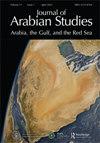AGAPS Graduate Paper Prize 2018: Winner
Q1 Social Sciences
引用次数: 0
Abstract
In examining British imperial control of the port of Basra in wartime and Mandate Iraq, Gabriel Young’s paper begins with a fascinating puzzle, asking: “How can an infrastructure both unify and fragment territory?” (p. 1). He directs his careful historical analysis to some tremendously rich empirical data, skillfully weaving together findings from his own archival research and the existing literature. Young’s paper is an exceptional example of how historians have successfully deployed the lens of space and infrastructure, the focus of research in the field of geography, to pose new and exciting questions about power and colonial governmentalities in the Middle East and around the world. In turning these insights to the Gulf region, Young demonstrates how a spatial strategies were key to enabling British control of Basra, and allowing colonial administrators to extend their “jurisdiction far beyond the physical limits of the actual infrastructure, into the overlapping territory of sovereign nation-states, semi-autonomous municipalities, and transnational corporations... , strategically reinterpreting and remaking the political, legal, and even physical space of Basra and its environs” (p. 2). The paper is well written and skillfully embedded in wider historical literature and its findings are of relevance far beyond Middle Eastern area studies. It analyses the subtleties of multi-layered imperial rule with great finesse. Key themes like the intrusion of military-supported capitalism and the emergence of new social and economic hierarchies in the British empire, but also the legalistic creativity of colonial authorities, are woven together into a compelling narrative. The diverging interests of APOC and of colonial authorities are investigated with particular subtlety.2018年AGAPS研究生论文奖:优胜者
在研究战时英帝国对巴士拉港口的控制和伊拉克托管时,加布里埃尔·杨(Gabriel Young)的论文以一个令人着迷的谜题开始,他问道:“一个基础设施如何既能统一又能分裂领土?”(第1页)。他对一些极其丰富的经验数据进行了仔细的历史分析,巧妙地将自己的档案研究和现有文献的发现编织在一起。杨的论文是历史学家如何成功地运用空间和基础设施(地理领域的研究焦点)的视角,提出有关中东和世界各地权力和殖民政府的新问题的一个杰出例子。在将这些见解转化为海湾地区时,杨展示了空间战略是如何使英国控制巴士拉的关键,并允许殖民管理者将他们的“管辖权远远超出实际基础设施的物理限制,进入主权民族国家,半自治市和跨国公司的重叠领土……“战略性地重新解释和改造巴士拉及其周边地区的政治、法律甚至物理空间”(第2页)。这篇论文写得很好,巧妙地融入了更广泛的历史文献,其发现的相关性远远超出了中东地区的研究。它巧妙地分析了多层次帝国统治的微妙之处。关键主题,如军事支持的资本主义的入侵,大英帝国新的社会和经济等级制度的出现,以及殖民当局的法律创造力,都交织在一起,形成了一个引人注目的叙事。对APOC和殖民当局的不同利益进行了特别细致的调查。
本文章由计算机程序翻译,如有差异,请以英文原文为准。
求助全文
约1分钟内获得全文
求助全文

 求助内容:
求助内容: 应助结果提醒方式:
应助结果提醒方式:


